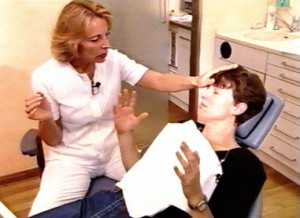

Dental treatment with hypnosis
Who doesn’t know it: the fear of the dentist. Hypnosis can help here. It reduces anxiety and calms you down. Hypnosis is a technique of deep trance and attainment of inner peace. It is therefore certainly a helpful instrument, especially in dentistry.
Hypnosis used to be equated with sleep. In Greek mythology, hypnosis was the god of sleep. But hypnosis and sleep are different states of consciousness. Unlike hypnosis, reflex intensity during sleep is significantly reduced. A sleeping person is usually not aware of his condition. This occurs very rarely under hypnosis (spontaneous amnesia). So far, I have only seen one case in my practice in which a patient could not remember smoking after giving up smoking.
Through modern medical hypnosis, the patient is put into a relaxed trance state in which he concentrates on pleasant imaginary images. He is mentally at his resting place and has “handed over his mouth for repair”. In a trance state, the rational part of the brain switches off – the patient can hide all unpleasant sensations and feel comfortable during the dental treatment. The pulse is calm, the blood pressure is low, deep abdominal breathing provides heaviness and warmth to the body, the entire musculature is relaxed. This avoids anxious cramping, facilitates access to the surgical area and the dentist can work precisely, quickly and concentrated on a relaxed patient.
The advantages of treatment under hypnosis are obvious:
- less or no medication
- better bleeding control
- less complaints
- Improvement of wound healing
- Reduction of anxiety and reassurance
- Overcoming acute pain
The dental indication of treatment under hypnosis:
- dental anxiety
- Syringe allergy and intolerance
- Bruxism (grinding of teeth and the associated consequences)
- gag reflex
During the treatment there is improved hemostasis and healing of the wound area. In dental prosthetics, the required impressions become more accurate as the salivary flow is reduced and the gag reflex is stopped. Dental functional diagnostics also benefits from hypnosis, as jaw joint problems are significantly minimized by reducing teeth grinding and pressing. By increasing the pain threshold, the amount of anaesthetics can be drastically reduced. Interestingly, pain-free treatment without anaesthesia works very well if there is an allergy or phobia to injections or if the patient has an urgent desire for treatment without an injection.
Hypnosis is a tried and tested method to experience a subjective reduction in time, i.e. the time of treatment appears to the patient to be considerably shorter. Therefore, patients under hypnosis, who normally have no problems with visiting the dentist, can be treated more often.
In summary it can be said that hypnosis can represent an enormous simplification of the treatment process for every patient and also an enrichment. Our creative resources lie in the unconscious. Hypnosis activates power, strength, self-confidence and self-healing. Patients often report a feeling of well-being that lasts for days after the treatment, which even makes the treatment itself appear unimportant. And some get with the new “bite” a new job or new courage to live.
As a member of the German Society for Dental Hypnosis (DGzH) and graduate of the Milton-Ericson-Society (MEG) I have several years of practical experience in relaxation techniques and medical hypnosis. In recent years, several TV teams (Deutsche Welle, PRO7, SAT1, TV Berlin) have recorded the treatment under hypnosis here in practice. We are happy to show you the recordings so that you can get an idea of the hypnosis treatment.
More information on this topic can be found under Publications
If you have any further questions, please do not hesitate to contact me personally.
anxiety patients
In most cases, dental anxiety is caused by one or more unpleasant experiences during dental treatment.
One thing is for sure – it takes patience and loving attention to take the fear out of a child. As parents, you know this best. What is advisable in this context for a visit to the dentist, we have written down here.
Tip 1 Talk to your child more often about the topic “Healthy begins in the mouth”. Explain it playfully, with simple, understandable and convincing words.
- how tooth decay develops – and what you can do about it
- why milk teeth in particular need to be cared for regularly and properly
- why the dentist should also check the teeth of children regularly
Tip 2 Before your child goes to the dentist for the first time, you should tell him something about his activities, his equipment and the people who help him. Take the child to the dentist “just so” – so that he or she can familiarize himself or herself with the new environment on the spot. During this visit you should definitely inform the dentist and his assistant that your child is coming to a practice for the first time. Avoid the sentence: “You don’t have to be afraid.”
Tip 3 Set a good example, because you are a role model for your child in everything you do. Always show that a visit to the dentist is normal for you.
Tip 4 Do not mislead your child. Tell him that the dentist has to drill if he finds a sick tooth and that drilling can hurt. But the dentist can let the tooth “fall asleep” and it only pinches for a short moment (Important! Avoid the word syringe!).
Tip 5 It would be wrong if you promised your child gifts before the visit to the dentist; praise him afterwards for his “great behaviour” during the treatment. Important: Children up to the age of 4 should always be praised – discuss their experiences with older children.
Children are treated in our practice with the so-called distracting relaxation techniques, e.g. the magic hand.
psychosomatics
In psychosomatics we assume that diseases are never only and exclusively organic, but that the overall condition of the patient always plays an important role. This is just as true for general medicine as it is for dentistry. A classic example of this is the grinding of teeth. Tensions built up during the day are compensated at night by teeth grinding. A consequence of this gnashing of teeth can then be periodontosis, for example.
In our practice we have made it our task to provide psychotherapeutic support in addition to the classical medical approach for such diseases. By early recognition of psychosomatic connections it can be avoided that illnesses become chronic.
